Exhibits play a crucial role in enhancing educational value by offering immersive experiences that engage visitors and promote learning. By combining various sensory elements, they create a rich environment for exploring historical contexts, revealing the cultural and social dynamics that have shaped our societies. These exhibits not only provide insights into our past but also help individuals understand contemporary issues through the lens of history.
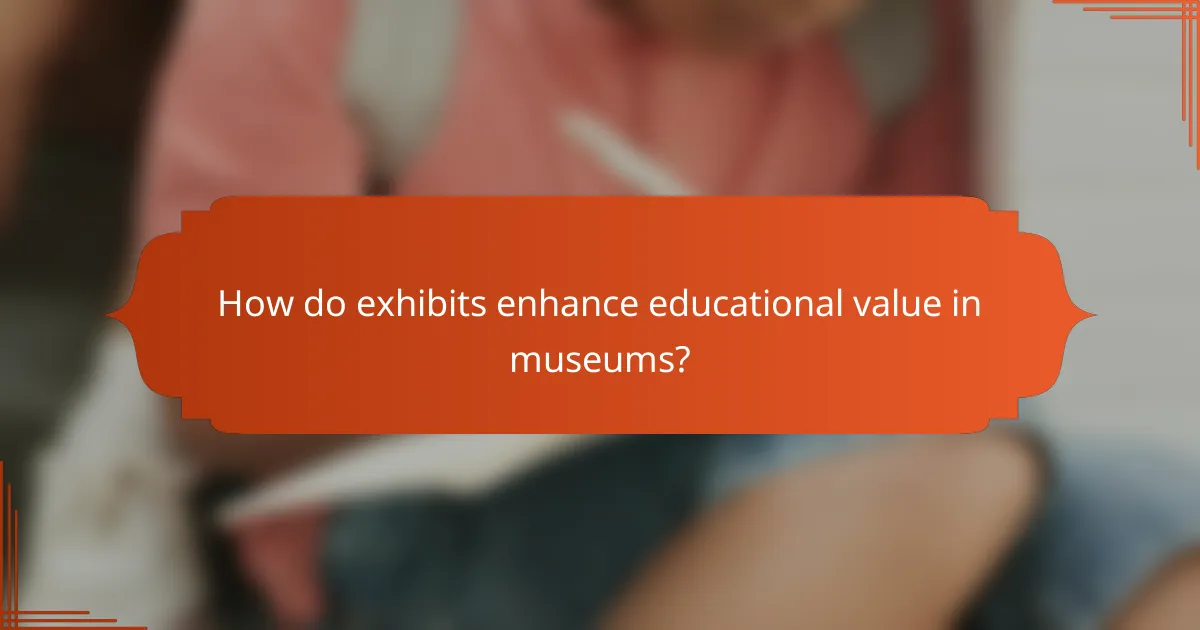
How do exhibits enhance educational value in museums?
Exhibits enhance educational value in museums by providing immersive experiences that engage visitors and facilitate learning. They combine visual, auditory, and tactile elements to create a rich environment for exploration and understanding of historical contexts.
Interactive displays
Interactive displays allow visitors to engage directly with the content, making learning more dynamic and memorable. These can include touch screens, augmented reality features, or physical artifacts that encourage hands-on interaction.
For example, a museum might feature a digital map that visitors can manipulate to explore historical events, enhancing their understanding of geography and context. Such displays cater to various learning styles, appealing to visual, auditory, and kinesthetic learners alike.
Curated historical narratives
Curated historical narratives present stories in a structured manner, guiding visitors through a timeline or thematic exploration. This approach helps contextualize artifacts within broader historical frameworks, making the information more relatable and impactful.
By weaving together personal stories, significant events, and cultural insights, museums can create a compelling narrative that resonates with visitors. This method encourages deeper reflection and connection to the material, fostering a more profound educational experience.
Hands-on learning experiences
Hands-on learning experiences allow visitors to actively participate in their education, often through workshops or demonstrations. These activities can include crafting, cooking, or other practical applications related to the exhibit’s theme.
For instance, a history museum might offer a workshop on traditional crafts, enabling participants to create items using historical techniques. Such experiences not only reinforce learning but also promote skill development and creativity.
Community engagement programs
Community engagement programs connect museums with local audiences, fostering a sense of ownership and relevance. These initiatives can include lectures, guided tours, or collaborative projects that involve community members in the museum’s mission.
By tailoring programs to reflect local history and culture, museums can enhance their educational value and encourage participation. Engaging the community helps ensure that exhibits remain relevant and accessible, ultimately enriching the learning experience for all visitors.
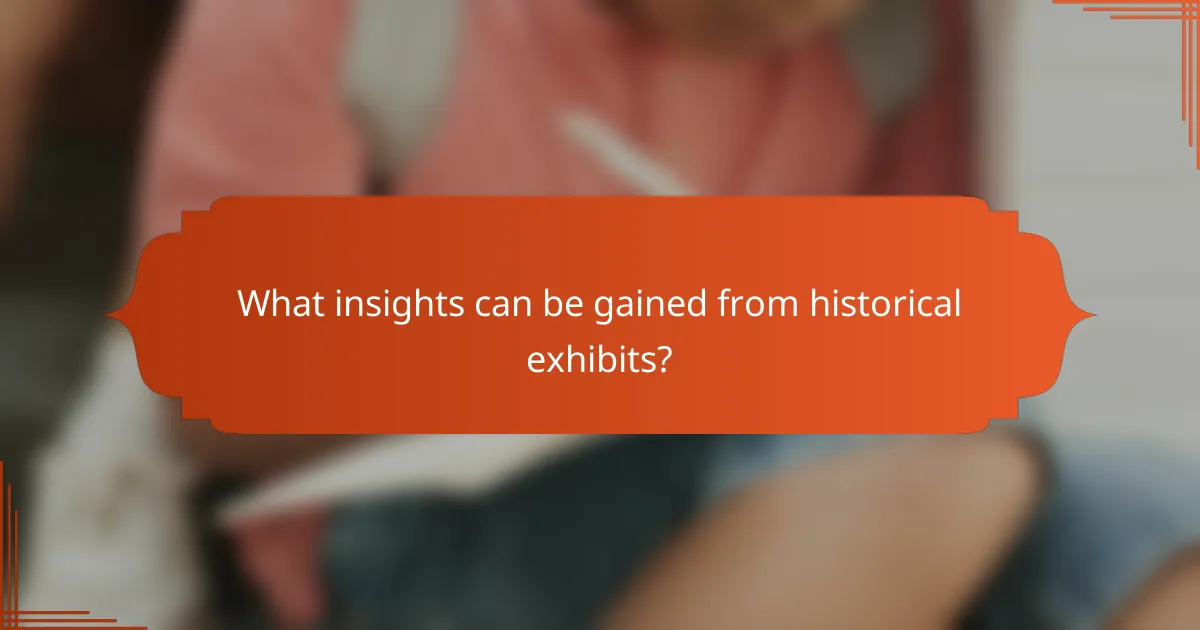
What insights can be gained from historical exhibits?
Historical exhibits provide valuable insights into our past, revealing the cultural, social, and political dynamics that have shaped societies. They serve as educational tools that foster understanding and appreciation of diverse histories and experiences.
Understanding cultural heritage
Historical exhibits play a crucial role in preserving and showcasing cultural heritage. They highlight the traditions, art, and values of different communities, allowing visitors to connect with their roots and appreciate the diversity of human expression. For instance, an exhibit on indigenous cultures may display artifacts, clothing, and stories that reflect the unique identity of these groups.
By engaging with these exhibits, individuals can gain a deeper understanding of their own cultural backgrounds as well as those of others, fostering respect and empathy across different cultures.
Lessons from past events
Historical exhibits often focus on significant events that have shaped nations and societies, offering lessons that remain relevant today. For example, an exhibit on World War II might explore the causes and consequences of the conflict, emphasizing the importance of diplomacy and conflict resolution. Such insights can help prevent the repetition of past mistakes.
Visitors can also learn about social movements, such as civil rights or women’s suffrage, which illustrate the power of collective action and the ongoing struggle for equality. These lessons encourage critical thinking about current issues and inspire individuals to engage in civic activities.
Influence on contemporary society
Historical exhibits illuminate the connections between past and present, showing how historical events influence contemporary society. For example, an exhibit on the Industrial Revolution may highlight technological advancements that continue to shape modern economies and lifestyles. Understanding these connections can help individuals appreciate the complexities of current societal challenges.
Moreover, these exhibits can inspire innovation by showcasing how past thinkers and creators addressed problems of their time. This perspective encourages contemporary audiences to draw parallels and apply historical insights to current issues, fostering a sense of continuity and progress in societal development.
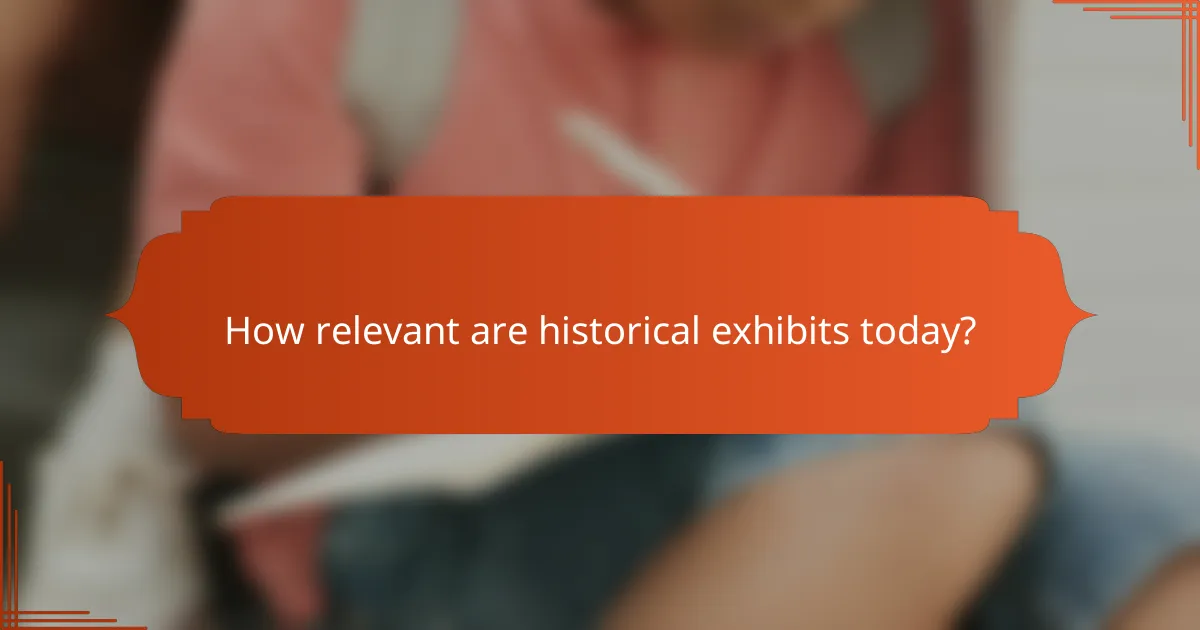
How relevant are historical exhibits today?
Historical exhibits remain highly relevant today as they provide insights into past events, cultures, and societal changes. They serve as educational tools that help individuals understand contemporary issues through the lens of history.
Addressing current social issues
Historical exhibits can illuminate current social issues by drawing parallels between past and present struggles. For instance, exhibits on civil rights movements can foster discussions about ongoing inequalities and inspire activism. By showcasing historical contexts, they encourage visitors to reflect on how history shapes modern society.
Exhibits that focus on topics like immigration, gender equality, or environmental changes can provide critical insights into today’s debates. They help audiences understand the roots of these issues, promoting a more informed and engaged citizenry.
Promoting critical thinking
Engaging with historical exhibits encourages critical thinking by challenging visitors to analyze and interpret information. Visitors are prompted to question narratives, consider multiple perspectives, and evaluate the reliability of sources. This analytical approach fosters a deeper understanding of history and its complexities.
For example, interactive displays that present conflicting viewpoints on historical events can stimulate discussions and debates among visitors. This engagement not only enhances critical thinking skills but also promotes a culture of inquiry and exploration.
Encouraging lifelong learning
Historical exhibits inspire lifelong learning by sparking curiosity about the past and its relevance to the present and future. They often provide resources for further exploration, such as books, documentaries, and online courses, encouraging visitors to delve deeper into topics of interest.
Many museums and cultural institutions offer programs and workshops that extend learning beyond the exhibit itself. Participating in these activities can help individuals of all ages develop a continuous interest in history and related fields, fostering a habit of lifelong education.
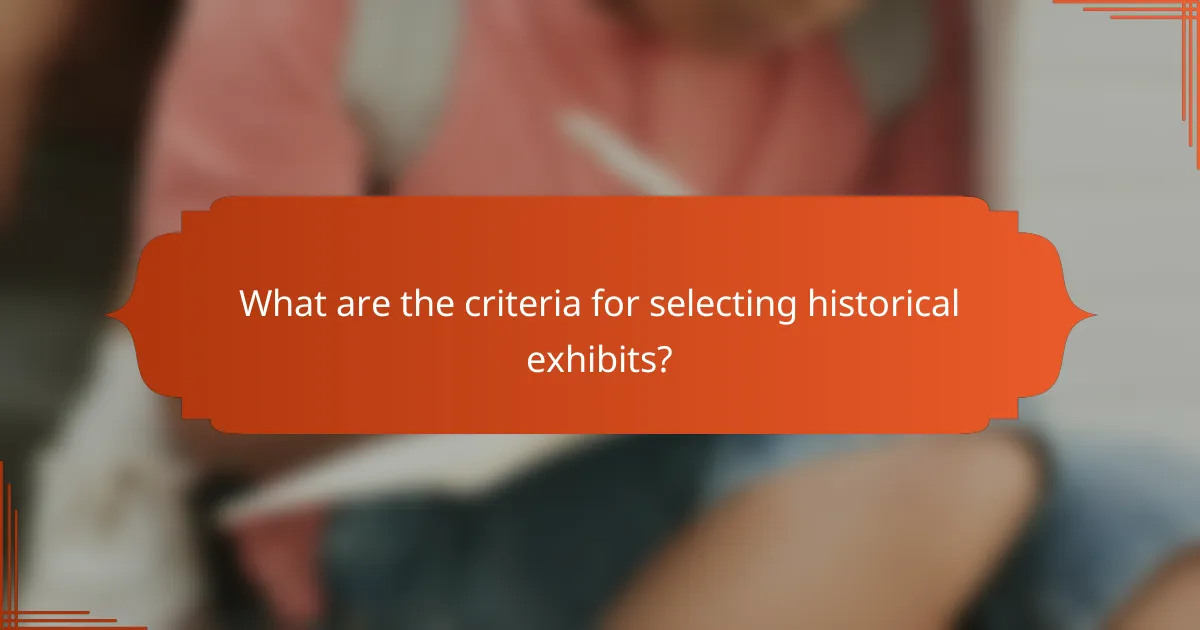
What are the criteria for selecting historical exhibits?
Criteria for selecting historical exhibits include relevance to current events, audience engagement potential, and the authenticity of artifacts. These factors ensure that exhibits resonate with visitors and provide meaningful educational experiences.
Relevance to current events
Exhibits should connect historical themes to contemporary issues, allowing visitors to draw parallels and gain insights. For example, an exhibit on civil rights can highlight ongoing social justice movements, making the content more relatable and impactful.
When selecting exhibits, consider how historical narratives can inform current debates or challenges. This relevance can enhance visitor interest and encourage critical thinking about both past and present societal dynamics.
Audience engagement potential
Engagement is crucial for a successful exhibit, as it determines how well visitors interact with the material. Consider incorporating interactive elements, such as multimedia displays or hands-on activities, to foster a deeper connection with the history presented.
Additionally, tailoring exhibits to specific demographics can increase engagement. For instance, family-friendly exhibits might include storytelling sessions or guided tours that cater to children, while adult-focused exhibits could feature expert talks or panel discussions.
Authenticity of artifacts
The authenticity of artifacts is essential for establishing credibility and trust with visitors. Curators should prioritize original items or high-quality reproductions, as these contribute to a genuine understanding of the historical context.
When assessing artifacts, consider provenance and condition. Items with well-documented histories or those that are in good condition can significantly enhance the educational value of an exhibit, allowing visitors to appreciate the tangible connections to the past.
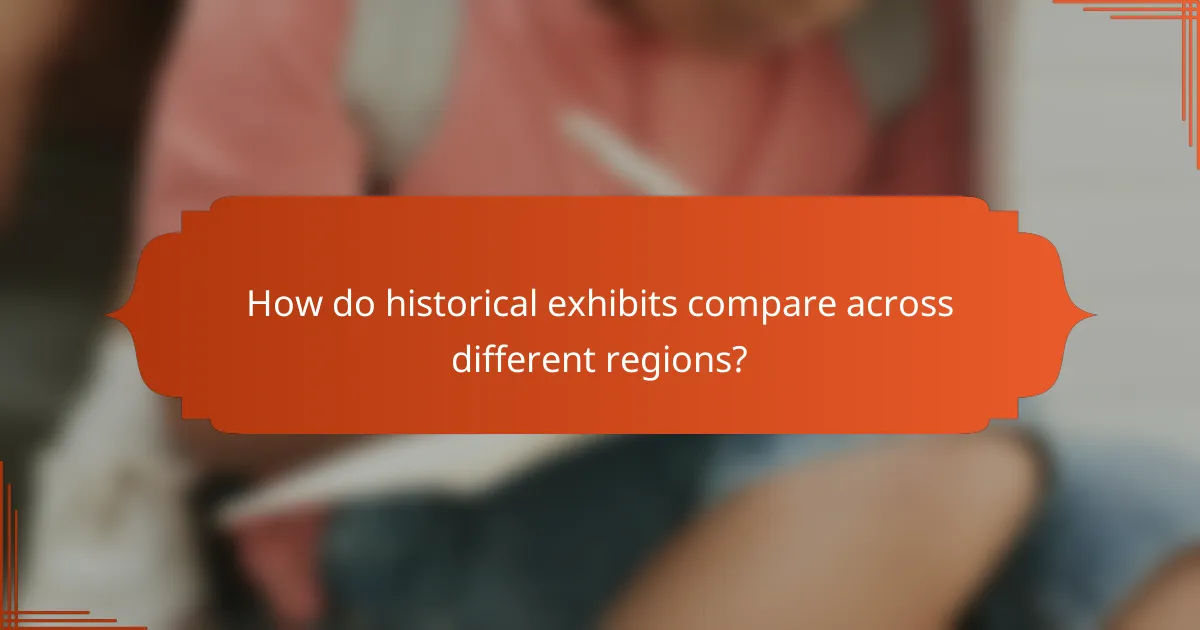
How do historical exhibits compare across different regions?
Historical exhibits vary significantly across regions, reflecting local cultures, histories, and educational priorities. These differences can influence the themes presented, the methods of education employed, and the overall impact of local history on the narratives shared.
Regional themes in exhibits
Exhibits often highlight themes that resonate with the local population, such as indigenous cultures in North America or colonial histories in parts of Africa and Asia. For instance, European exhibits may focus on the Renaissance and Enlightenment, while Latin American displays often emphasize pre-Columbian civilizations and colonial encounters.
These regional themes not only showcase unique historical narratives but also foster a sense of identity and pride among local communities. By emphasizing local stories, exhibits can engage visitors more deeply and encourage a connection to their heritage.
Variations in educational approaches
Educational approaches to historical exhibits differ widely, influenced by cultural attitudes towards learning and history. In some regions, interactive exhibits that encourage visitor participation are favored, while others may rely more on traditional displays and guided tours.
For example, Scandinavian countries often incorporate technology and multimedia to enhance learning experiences, whereas many Asian countries might emphasize storytelling and oral traditions. Understanding these variations can help curators design exhibits that resonate with their target audiences.
Impact of local history
The impact of local history on exhibits is profound, shaping not only the content but also the methods of presentation. In regions with rich historical narratives, such as the American South or the Mediterranean, exhibits may include extensive artifacts and immersive experiences that reflect the complexity of local histories.
Conversely, areas with less documented histories might focus on broader themes or comparative histories to fill gaps. This can lead to innovative approaches that highlight connections between different cultures and histories, enriching the visitor experience.

What are the emerging trends in historical exhibitions?
Emerging trends in historical exhibitions focus on enhancing visitor engagement and accessibility through technology and interactive experiences. These trends include the integration of virtual reality, augmented reality, and immersive storytelling, which provide deeper insights into historical contexts.
Virtual reality experiences
Virtual reality (VR) experiences in historical exhibitions allow visitors to immerse themselves in different time periods and events. By using VR headsets, attendees can explore reconstructed environments, interact with historical figures, and witness significant moments as if they were present.
When implementing VR, consider the technical requirements, such as hardware compatibility and software development. Ensure that the experience is user-friendly and accessible to a wide audience, including those who may not be familiar with VR technology.
For example, a museum might offer a VR experience that transports visitors to ancient Rome, allowing them to walk through the Forum and interact with digital representations of historical figures. This type of engagement can significantly enhance learning and retention of historical information.
